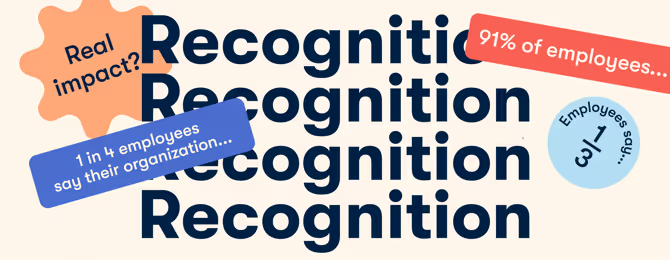9 Intriguing statistics about employee disengagement

Discover Workleap Officevibe's benchmark report on 12 key employee engagement metrics

There are myriad reasons why your employee might be having a rough day at work; maybe their car broke down on their way to the office or maybe they've been struggling with a personal matter. But let's face it: as much as we'd like to check these things at the door when we log on to work, these external factors can affect employee engagement and concentration. We're only human after all.
But if you begin to notice recurring patterns of chronic absenteeism, listlessness, an inability to focus, or just a general disconnection from your employees, your team might be struggling with maintaining healthy employee engagement.
For companies to reverse, or better yet, prevent the damaging effects of actively disengaged employees, managers should keep a watchful eye on 10 employee engagement metrics, including the relationship between employees and managers, overall happiness, company alignment, relationship with colleagues, and personal growth.
What is employee disengagement?
Before we explore some of the more conspicuous employee engagement statistics we uncovered, let's define employee engagement, or lack thereof.
When a team experiences high employee engagement, their people feel connected emotionally and mentally to their jobs. They feel invested in their roles and the company and are motivated to perform to the best of their abilities. When your employees are not engaged at work, you'll notice a general lack of enthusiasm and interest in their day-to-day tasks.
Some early signs of disengagement can occur when:
- An employee consistently misses deadlines
- An employee no longer reaches out to their teammates
- An employee who used to share creative ideas in meetings begins to retreat
{emphasize}Take stock of your team and look out for other warning signs of disengagement so you can start boosting engagement and employee retention.{emphasize}
Causes of disengaged employees
There are many causes of employee disengagement, but it's important to note that as a manager, you can take steps towards helping your employees mend their fractured relationships with their work.
Some common causes of low employee engagement include:
- Lack of feedback and direction from their manager
- Lack of socializing with peers
- Lack of understanding or connection to the core mission and values of the company
- Feeling underappreciated and unrecognized for their work
- An incomplete onboarding
- Feeling that they are not properly compensated for their work
- Few career advancement opportunities
9 statistics on employee disengagement
In Officevibe's recent data report on the state of employee experience, we observed some thought-provoking employee engagement stats. While some of them may seem jarring at first, rest assured that there are ways to turn things around to support a team of highly engaged employees.
Job satisfaction needs to be improved
Job satisfaction is integral to maintaining high employee engagement. According to Officevibe statistics, 42% of employees don't feel like they're adequately compensated for their work, which can lead to resentment and a negative view of your organization.
If you don’t know how employees feel about your company, you can get a pretty good idea using the employee Net Promoter Score (eNPS) by asking them: “On a scale of 0 to 10, how likely are you to recommend our organization as a place to work to others?”
Ultimately, you want to have your employees acting as promoters for your company – not neutrals, and certainly not detractors. This will help you both attract top talent and improve employee retention.
Focus on these areas to improve job satisfaction:
- Workload: Do your employees have too much work to complete in an unrealistic amount of time? Do they need to work on the weekends, stay long hours, and neglect a work-life balance?
- Benefits: Does your company offer perks and benefits that are desirable for your employees– enough that they are excited to come to work? Think beyond health benefits.
- Salary: Employees need to feel that they are properly compensated for their work, and if they don’t, then there is no doubt that the quality of their work will be affected.
{emphasize}💡Try these 12 tips to improve job satisfaction on your team.{emphasize}
Relationships with managers are unsteady
As a manager, the relationships you foster with your people can have a huge impact on your team's overall employee engagement. We found that 75% of employees who leave their jobs or display low levels of engagement say that it's due in part to their managers or broader company leadership.
It's also important to note that 70% of people wished they could actually spend more time with their managers to create a stronger connection with them and with the organization.
How to improve your employee-manager relationships:
While there's no one-size-fits all solution to building strong relationships with your teammates, the following strategies can help with improving employee engagement:
- Communicate constantly: Hold regular one-on-one meetings to go over your employee’s work and give them constructive ways in which they can improve. This is also a great opportunity to listen to your team and collect their honest feedback to see what you can do to keep your employees actively engaged.
- Bring some pzazz to the team: Who says work can't be fun? Strengthen your bonds with your teammates and get to know the people behind the screens through different employee engagement activities like innovation challenges, lunch and learns, and creative workshops.
- Recognize their hard work: And do this as often as possible. Recognition is one of the lowest-cost, but most important ways to keep employees engaged. By offering meaningful recognition messages, you're acknowledging their efforts and letting your employees know that you value them.
- Encourage work-life balance: It’s really important that your employees know that you value them as complete individuals, not just workers. Expecting them to stay late every day, reaching out after business hours, and not showing an interest in who they are outside of the office are all ways to disengage your employees and create a negative view of the company culture.
Insufficient recognition
We briefly touched on the importance of employee recognition, but it's worth noting that 1 in 4 employees don't feel like their organizations celebrate accomplishments or learnings. A thriving company culture is one that highlights employee achievements, but also recognizes efforts and small victories.
Recognition doesn't (and shouldn't) have to come in the form of a Starbucks gift card or even a very public praise wall.
Some ways to increase recognition in the workplace include:
- Advocating for regular virtual recognition
- Acknowledging work anniversaries and other milestones
- Carving out time for shout outs during team events
{emphasize}✨ When you highlight employee contributions, everyone shines. Officevibe's peer-to-peer recognition tool, Good Vibes, allows you to celebrate both the big wins and subtle triumphs.{emphasize}
[ov_cta id="5119972"]
Misalignment with role expectations
It’s vital that your employees know exactly what is expected from them. This might seem obvious, but 75% of employees stated that their managers could define more precise goals.
Often lines get blurred and it can become anxiety-inducing to not know your exact job or role. Make sure to provide employees with clear goals and expectations. With tools like Officevibe, you can set individual and team objectives with an intuitive goal-setting framework
Make sure your team is aligned with company values and goals:
- For your team to move forward together as a united front and ensure company success, it's important for your team to be aligned with the company's values.
- When an employee feels connected to their organization's mission and business strategy, they are more likely to enjoy their work. When goals and values are both understood and aligned, and employees feel included in the progress of the company toward these goals, they are sure to be more engaged.
{emphasize}The first step in fixing the disconnect is to be transparent with your team. Let them know your goals and be open about sharing numbers and high-level communications. Including your team in every detail of the company’s value and purpose will make them feel part of something bigger.{emphasize}
Feedback is not frequent enough
Only 25% of employees feel like the feedback they receive from their managers is frequent enough to help them improve and reach their goals. If you notice that your employee is struggling with certain tasks, waiting to talk to them about it at a “TBD later date” won’t do much in helping inspire them or overcome the challenge.
Here are a few reminders on how to give effective employee feedback:
- Keep it constant: This includes everything from praise for good work to constructive criticism for projects that can use improvement. Monthly check-ins and annual reviews do serve a purpose, but details may fall through the cracks over time. Continuous dialogue creates an open channel of communication with your teammates.
- Remind them that feedback is for them: It’s important to let employees know that any feedback sessions are for them. That they are safe places to discuss anything that they feel concerned about or want to work on and improve. Making the feedback process positive makes receiving feedback (even negative) less daunting because employees know that you are both working towards the same goal of helping them feel and be the best they can be.
- Make feedback anonymous: Employees will be more inclined to share what's on their minds if they can speak freely. By making feedback anonymous, you're focusing on the message, not the messenger.
- Ask for feedback on your performance: It’s a universal truth that there is always room for growth, so ask your employees for feedback on your performance as a manager. You can boost employee engagement by checking in with your team to learn which areas you excel in, and which could be improved on.
{emphasize}There are no two ways about it: feedback is crucial to improving employee retention and engagement. Learn more in our comprehensive guide on employee feedback
{emphasize}
Employee wellness has taken a hit
The pandemic has brought about a whole new set of challenges for the workplace, with employee well-being and mental health at the top of the list of casualties. Officevibe data has shown that 47% of employees regularly feel overwhelmed, with an unfortunate 26% feeling like their managers aren't concerned with the state of their mental health. Nobody's well-being should be forgotten, or even an afterthought.
{emphasize}If your company has adopted a hybrid work model, make sure you continue to engage with your remote employees as you would if they were in the office. There are tons of ways to boost morale and nurture a team of engaged employees, in person or virtually, most of which won't set you back at all.
💡Keep things fresh and explore some of these 14 employee engagement ideas your team will love.{emphasize}
Touch base with your team and ensure they're feeling supported by asking them some of the following employee wellness survey questions:
- On a scale of 1 to 10, please rate your degree of work-related burnout.
- What wellness-promoting initiatives would you like to see in the workplace?
- On a scale of 1 to 10, how much do you agree with the following: “I enjoy an optimal work-life balance at my current job”?
- Does your workload leave you enough time to pursue hobbies, personal activities, or career development?
Too few career advancement opportunities
Employee expectations have shifted in recent years; most modern professionals are no longer content with staying static in their positions and are eager to grow at their companies. But 40% of employees note that they don't have a development plan to help them improve their skills and drive their growth.
As a manager, you can keep your employees engaged by helping them sharpen their skills or learn new industry trends. By offering your employees career development opportunities, you're letting them know that you're invested in them and want to keep them around for the long-haul.
{emphasize}💡Take on a mentorship role for your employees to help improve employee engagement with these seven techniques.{emphasize}
How to improve employee engagement on your team
Even if things seem a little bleak sometimes, it's never too late to turn things around and offer your team a great workplace experience and ensure your employees are engaged.
You can start improving employee engagement on your team by:
- Giving consistent employee feedback (and asking for it, too!)
- Conducting regular one-on-one meetings
- Focusing on employee well-being
- Implementing recognition programs
We know it can feel a little overwhelming at times, but employee engagement tools like Officevibe can help you build a positive company culture and increase employee engagement.
Get to know your team better and find out what works for them and what keeps them engaged.
Give HR and managers the clarity, confidence, and connection to lead better every day.


%20(1).avif)


.avif)
.avif)








